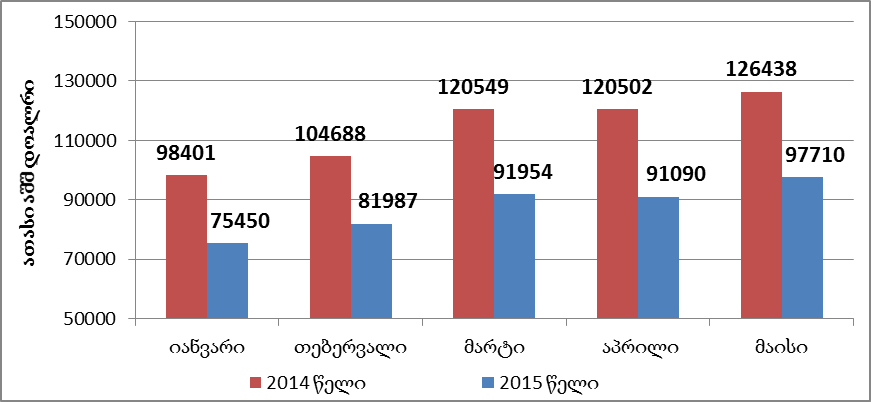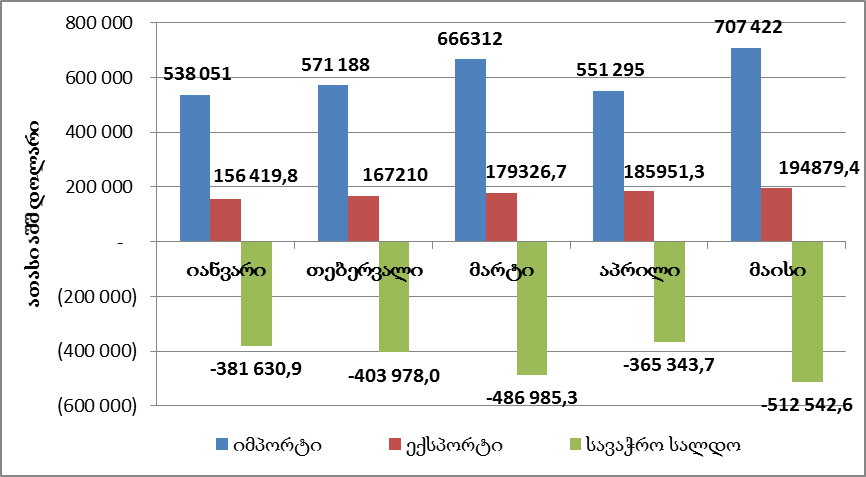At the investment session held in terms of the various events organised by the European Bank for Reconstruction and Development (EBRD), the Minister of Economy and Sustainable Development of Georgia, Giorgi Kvirikashvili, stated that there are noticeable positive trends in the economy which manifest themselves in the growing currency inflows from exports, tourism and money transfers.
FactCheck verified the accuracy of the aforementioned statement.
Revenues in Georgia, not only from exports but from other currency sources as well, have been decreasing from the second half of 2014 and had a significant influence upon the depreciation of the national currency. The trend of a decrease in exports continued at the beginning of 2015 as well whilst the national currency depreciated by 40 tetri (21%) as compared to the beginning of the year. The exchange rate reached its peak in May 2015 when the exchange rate of GEL with regard to USD was set at 2.36. Later, the exchange rate of GEL with regard to USD started to strengthen. As of today, the exchange rate of GEL with regard to USD is 2.25.
The recent strengthening of the exchange rate is being attributed to the growth of revenues from currency sources. The main sources of foreign currency for Georgia include the revenues from exports, money transfers, tourism and foreign investments. The dynamics of the country’s currency income are shown in its balance of payments.
According to the data of the National Bank of Georgia, the current account deficit (includes external trade, money transfers and factor revenues) reached USD 465 million in the first quarter of 2015. The deficit was USD 365 million in the first quarter of 2014. The current account deficit is partly compensated by the growth of financial and capital accounts. The aforementioned growth was mainly due to the growth of liabilities of the private sector and the growth of short-term trade loans. As for foreign investments, their amount has decreased. Foreign direct investments (FDI) reached USD 175 million in the first quarter of 2015 which is 35% less than it was in the same period of the previous year (USD 272 million).
Revenues from tourism amounted to USD 306 million in the first quarter of 2015 which is 3% less than in the same period of the previous year. Information about the revenues from tourism from April to June 2015 is not available yet; however, according to the data of the Ministry of Economy and Sustainable Development of Georgia, the number of tourists in May and June was on the increase. FactCheck wrote about this issue earlier as well.
Money transfers from January to May 2015 amounted to USD 438 million which is USD 132 million (23%) less than in the same period of the previous year. The amount of money transfers shows a trend of growth from January; however, it is still less than the indicators of the previous year (see Chart 1).
Chart 1: Money Transfers in 2014 and from January to May 2015
 Source: National Bank of Georgia
As for external trade, according to the data of the National Bank of Georgia, exports amounted to USD 884 million from January to May 2015 which is 25% less than in the same period of the previous year.
The country’s monthly exports have a trend of increase from January but they are still less than in the corresponding months of the previous year. The country’s negative trade balance decreased in April 2015 which is mainly due to the drop in imports. However, imports grew again in May which caused the negative trade balance to increase to USD 512 million.
Chart 2: Georgia’s External Trade from January to May 2015
Source: National Bank of Georgia
As for external trade, according to the data of the National Bank of Georgia, exports amounted to USD 884 million from January to May 2015 which is 25% less than in the same period of the previous year.
The country’s monthly exports have a trend of increase from January but they are still less than in the corresponding months of the previous year. The country’s negative trade balance decreased in April 2015 which is mainly due to the drop in imports. However, imports grew again in May which caused the negative trade balance to increase to USD 512 million.
Chart 2: Georgia’s External Trade from January to May 2015
 Source: National Bank of Georgia
Conclusion
There is a trend of growth in exports and money transfers from abroad; however, the amount of both exports and money transfers is lower than in the same periods of the previous year. The number of tourists started to increase from May. Their number increased by 5.3% in May and by 3.3% in June. It should also be pointed out that in his statement the Minister of Economy and Sustainable Development of Georgia does not talk about another important source of foreign currency – foreign investments – whose amount decreased by 35% in the first quarter of 2015 as compared to the same period of the previous year.
FactCheck concludes that Giorgi Kvirikashvili’s statement is HALF TRUE.
Source: National Bank of Georgia
Conclusion
There is a trend of growth in exports and money transfers from abroad; however, the amount of both exports and money transfers is lower than in the same periods of the previous year. The number of tourists started to increase from May. Their number increased by 5.3% in May and by 3.3% in June. It should also be pointed out that in his statement the Minister of Economy and Sustainable Development of Georgia does not talk about another important source of foreign currency – foreign investments – whose amount decreased by 35% in the first quarter of 2015 as compared to the same period of the previous year.
FactCheck concludes that Giorgi Kvirikashvili’s statement is HALF TRUE.
 Source: National Bank of Georgia
As for external trade, according to the data of the National Bank of Georgia, exports amounted to USD 884 million from January to May 2015 which is 25% less than in the same period of the previous year.
The country’s monthly exports have a trend of increase from January but they are still less than in the corresponding months of the previous year. The country’s negative trade balance decreased in April 2015 which is mainly due to the drop in imports. However, imports grew again in May which caused the negative trade balance to increase to USD 512 million.
Chart 2: Georgia’s External Trade from January to May 2015
Source: National Bank of Georgia
As for external trade, according to the data of the National Bank of Georgia, exports amounted to USD 884 million from January to May 2015 which is 25% less than in the same period of the previous year.
The country’s monthly exports have a trend of increase from January but they are still less than in the corresponding months of the previous year. The country’s negative trade balance decreased in April 2015 which is mainly due to the drop in imports. However, imports grew again in May which caused the negative trade balance to increase to USD 512 million.
Chart 2: Georgia’s External Trade from January to May 2015
 Source: National Bank of Georgia
Conclusion
There is a trend of growth in exports and money transfers from abroad; however, the amount of both exports and money transfers is lower than in the same periods of the previous year. The number of tourists started to increase from May. Their number increased by 5.3% in May and by 3.3% in June. It should also be pointed out that in his statement the Minister of Economy and Sustainable Development of Georgia does not talk about another important source of foreign currency – foreign investments – whose amount decreased by 35% in the first quarter of 2015 as compared to the same period of the previous year.
FactCheck concludes that Giorgi Kvirikashvili’s statement is HALF TRUE.
Source: National Bank of Georgia
Conclusion
There is a trend of growth in exports and money transfers from abroad; however, the amount of both exports and money transfers is lower than in the same periods of the previous year. The number of tourists started to increase from May. Their number increased by 5.3% in May and by 3.3% in June. It should also be pointed out that in his statement the Minister of Economy and Sustainable Development of Georgia does not talk about another important source of foreign currency – foreign investments – whose amount decreased by 35% in the first quarter of 2015 as compared to the same period of the previous year.
FactCheck concludes that Giorgi Kvirikashvili’s statement is HALF TRUE.
Tags:







